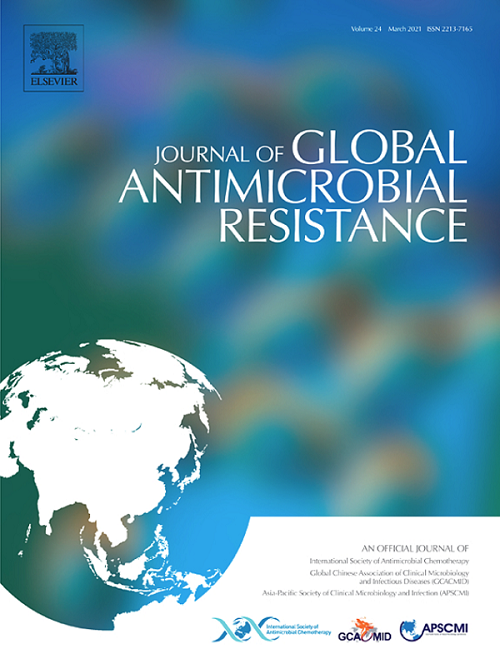First report of regional spreading and long-term inhabitation of VanD-type vancomycin-resistant Enterococcus faecalis clinical strains: A proposal of new classification of vanD gene subtypes
IF 3.2
3区 医学
Q2 INFECTIOUS DISEASES
引用次数: 0
Abstract
Objective
VanD-type vancomycin resistance is rarely reported in Enterococcus faecalis. This study aimed to characterise five VanD-type vancomycin-resistant E. faecalis strains isolated over 8 years from three hospitals in a local city in Japan, with a focus on resistance mechanisms, genetic background, and phylogenetic classification.
Methods
Five E. faecalis strains (SVR2085, SVR2281, SVR2330, SVR2331, and SVR2332) were analysed using antimicrobial susceptibility testing, plasmid profiling, and whole-genome sequencing. Genomic islands (GIs) containing vanD gene clusters were characterised. Core GI gene and core genome phylogenies were compared, and vanD homologues were classified using public database sequences.
Results
All strains exhibited high-level resistance to vancomycin (MIC >1024–64 mg/L), multiple drug resistance, and carried pheromone-responsive plasmids encoding bacteriocin 41 as a colonisation factor. Four strains shared nearly identical GIs (126–185 kbp), while SVR2330 had a structurally distinct GI. Phylogenetic analysis showed that the four similar strains formed a single cluster, suggesting a common ancestor, whereas SVR2330 was divergent. Comparative analysis of 37 vanD homologues revealed high genetic diversity, allowing classification into three subgroups – vanD(I), vanD(II), and vanD(III). The vanD of SVR2330 was assigned as vanD(III)-4, and the others as vanD(II)-6, -11, -15, and -17.
Conclusions
This study proposes a new classification scheme for diverse vanD genes and provides the first evidence of the regional spread and long-term persistence of VanD-type vancomycin-resistant E. faecalis in Japan.
vanD型耐万古霉素粪肠球菌临床菌株区域传播和长期居住的首次报道:vanD基因亚型新分类的提出
目的:粪肠球菌vand型万古霉素耐药报道较少。本研究旨在对日本某地方城市三家医院8年间分离的5株vand型耐万古霉素粪肠球菌进行特征分析,重点研究耐药机制、遗传背景和系统发育分类。方法:对5株粪肠球菌(SVR2085、SVR2281、SVR2330、SVR2331和SVR2332)进行药敏试验、质粒分析和全基因组测序。对含有vanD基因簇的基因组岛(GIs)进行了表征。比较核心GI基因和核心基因组系统发育,并利用公共数据库序列对vanD同源物进行分类。结果:所有菌株对万古霉素均表现出高水平耐药(MIC: 1024mg /L ~ 64mg /L)和多重耐药,并携带编码细菌素41的信息素响应质粒作为定植因子。4个菌株具有几乎相同的GI (126 ~ 185 kbp),而SVR2330具有结构上不同的GI。系统发育分析表明,4个相似菌株形成了一个聚类,表明它们具有共同的祖先,而SVR2330则具有不同的祖先。37个vanD同源物的比较分析显示出较高的遗传多样性,可将其分为vanD(I)、vanD(II)和vanD(III)三个亚群。将SVR2330的vanD分配为vanD(III)-4,其余vanD分配为vanD(II)-6、-11、-15、-17。结论:本研究为vanD型万古霉素耐药粪肠杆菌在日本的区域传播和长期存在提供了第一个证据。
本文章由计算机程序翻译,如有差异,请以英文原文为准。
求助全文
约1分钟内获得全文
求助全文
来源期刊

Journal of global antimicrobial resistance
INFECTIOUS DISEASES-PHARMACOLOGY & PHARMACY
CiteScore
8.70
自引率
2.20%
发文量
285
审稿时长
34 weeks
期刊介绍:
The Journal of Global Antimicrobial Resistance (JGAR) is a quarterly online journal run by an international Editorial Board that focuses on the global spread of antibiotic-resistant microbes.
JGAR is a dedicated journal for all professionals working in research, health care, the environment and animal infection control, aiming to track the resistance threat worldwide and provides a single voice devoted to antimicrobial resistance (AMR).
Featuring peer-reviewed and up to date research articles, reviews, short notes and hot topics JGAR covers the key topics related to antibacterial, antiviral, antifungal and antiparasitic resistance.
 求助内容:
求助内容: 应助结果提醒方式:
应助结果提醒方式:


